One of the most important things to know about a boat is its mileage. Of course, the mpg (miles per gallon) of a boat can differ drastically and depends on many factors. In this article, we will walk you through how many miles per gallon a boat gets in general by looking at the mileages of popular boat models.
On average, a standard boat gets around 3 mpg (miles per gallon) at MAX RPMs. However, the mileage can vary from as small as 0.5 mpg or less to as high as 8 mpg or more depending on the weather condition, boat’s weight, boat’s condition, RPMs, and most importantly, the boat’s engine type, etc.
Boats are not as fuel-efficient as cars. They consume a lot of gas compared to other vehicles due to their traversing in the waters. That’s the main reason why boats have bigger fuel tanks compared to other land-moving vehicles. Low mileage means requires more fuel.
Many small boats tend to get around 3 – 12 mpg at normal speeds (not at max RPMs), while faster boats like speed and motorboats will give 0.5 – 2.5 mpg. Depending on the boat’s weight, design, and, very importantly, the type of motor it has, the mpg or mileage changes drastically.
NOTE – All the mileages listed in the post are at max RPMs, not at cruising or normal speeds. And those values are based on the tests conducted by Yamaha and Mercury outboard companies, and some others are taken from outside.
An older boat with an older engine will have poor fuel mileage when compared to more modern boats. Here’s a table showing the different boat models and their average mileages.
| Boat Model | Miles Per Gallon (At Full Throttle) |
| Pontoon Boat | 1 – 10 mpg |
| Bass Boat | 3 – 12 mpg |
| Cabin Cruiser Boat | 0.5 – 2.5 mpg |
| Cuddy Cabin Boat | 1.5 – 4 mpg |
| Fishing Boat | 1 – 5 mpg |
Those are the average mileages of different boat models. OKAY, without further ado, let’s see the mpg of those different boats in a detailed way.
Related post – How Many Gallons Of Gas Does A Boat Hold? Check this article to know the average fuel tank sizes of 60 different boats.
How Many Miles Per Gallon Does A Pontoon Boat Get?
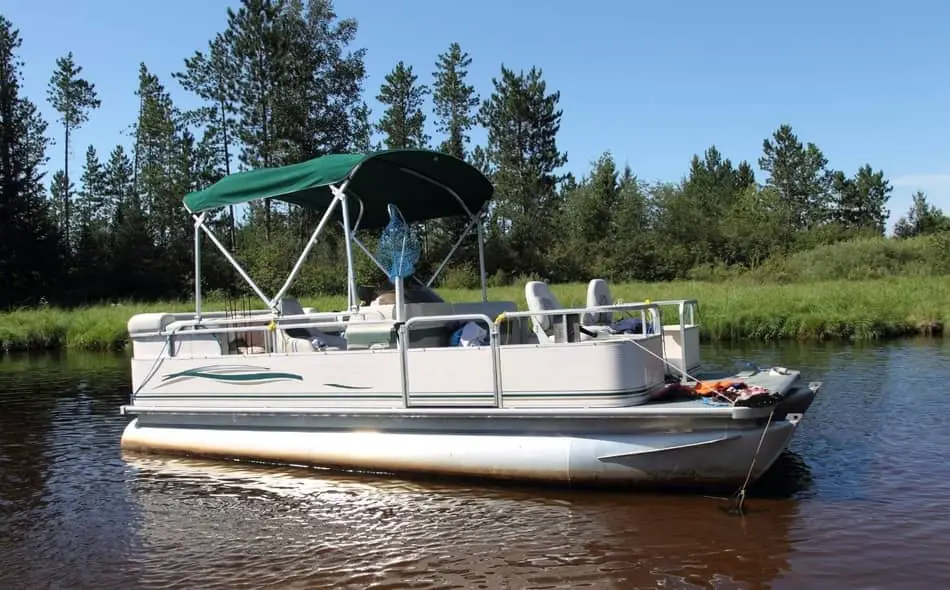
On average, a pontoon boat gets around 3.5 mpg (miles per gallon) at MAX RPMs. However, the mileage can vary from as small as 1.5 mpg or less to as high as 7 mpg or more depending on the weather condition, boat’s weight, boat’s condition, RPMs, and most importantly, the boat’s engine type, etc.
The average pontoon boat will get around 5 miles per gallon at normal speed (not max RPMs). This means that a 30 miles trip out on the water will take 6 gallons of gas.
Since pontoon boats are not deemed for racing or speed, many boats will achieve good mileage. Here’s a table showing the different pontoon boat models and their average mileages.
| Pontoon Boat Model | Engine | Miles Per Gallon (At Full Throttle) |
| Qwest 818 Adventure Cruise | Yamaha F40LA | 7.55 mpg |
| Sunchaser 818 Oasis Cruise | Yamaha F40LA | 6.66 mpg |
| Avalon Catalina 2185 CR | Yamaha F70LA | 3.25 mpg |
| Crestliner 200 Sprint | Mercury 115 hp | 3.1 mpg |
| Bentley 243 | Yamaha F150XB | 2.65 mpg |
| Barletta C22QC | Mercury 150 hp | 2.4 mpg |
| Avalon Catalina 2385 SQL | Mercury 175 hp | 2.4 mpg |
| Avalon Catalina 2585 QL | Mercury 250 hp | 2 mpg |
| Bennington 25 RTSB | Yamaha F300XCA | 1.55 mpg |
| Barletta L25UC | Mercury 400 hp | 1.3 mpg |
Pontoon boats are very popular among the boats. Their simple construction of the deck on two or three pontoon tubes makes it a very special boat. Two pontoons for most of the boats, but three pontoons go under the deck if the boat becomes larger and heavier.
Common pontoon boat designs are a catamaran with two hulls or a trimaran with three hulls. Boats with three hulls are sometimes called tri-toons. Pontoon boats are used for pleasure on lakes and rivers, and in some cases, on oceans close to shore.
Related post – What Fuel Do Boats Use? Check this article to know the types of fuels used in boats and their advantages & drawbacks in a detailed way.
How Many Miles Per Gallon Does A Bass Boat Get?
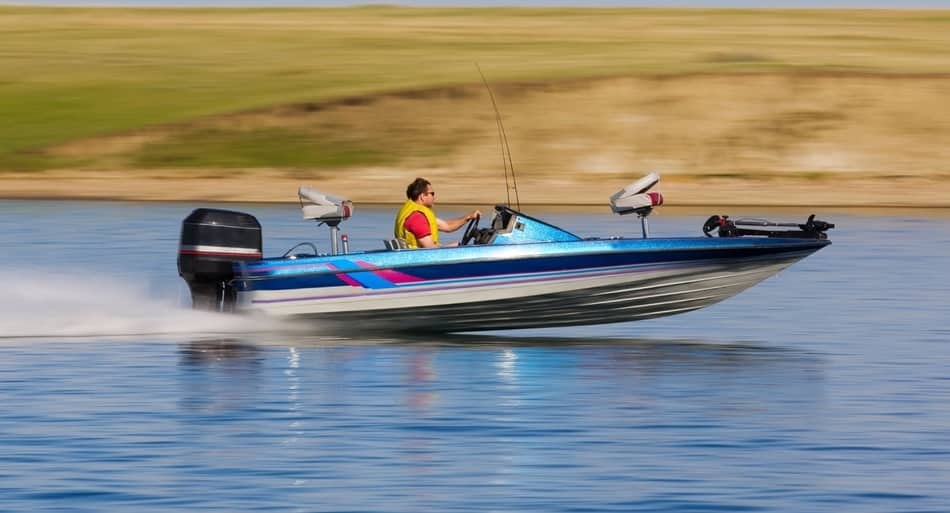
On average, a bass boat gets around 4 mpg (miles per gallon) at MAX RPMs. However, the mileage can vary from as small as 5 mpg or less to as high as 7 mpg or more depending on the weather condition, boat’s weight, boat’s condition, RPMs, and most importantly, the boat’s engine type, etc.
A bass boat is a small boat that is designed and equipped primarily for bass fishing or fishing for other panfish, usually in freshwaters such as lakes, rivers, and streams. Unlike some other boats, the bass boat promised a focus on fishing and nothing more.
Most of the bass boats are very light boats, and their simple construction gives more mileage than other boats. However, an average bass boat will consume between 4 – 5 gallons per hour at cruising speed.
Each angler is going to have their own preferences and desires for their bass boat. So let’s get into it. Listed here, we have some of the best bass boat models on the market, so let’s see how they compare when stacked up.
| Bass Boat Model | Engine | Miles Per Gallon (At Full Throttle) |
| Nitro Z21 | Yamaha F30LA | 7.68 mpg |
| Alumacraft Escape 145 CS | Yamaha F40LA | 7.55 mpg |
| Tidewater® 1672 Skiff | Yamaha F40LA | 6.66 mpg |
| Crestliner 1600 Storm | Mercury 50 hp | 7.6 mpg |
| Bass Cat Puma FTD | Yamaha F60LB | 5.8 mpg |
| Lowe Stinger 178 | Yamaha F70LA | 5.34 mpg |
| SmokerCraft 17 Excursion | Mercury 90 hp | 4.6 mpg |
| Alumacraft Competitor 185 Tiller | Yamaha F90XB | 3.85 mpg |
| Crestliner XFC 189 | Mercury 115 hp | 4.5 mpg |
| Crestliner PT 20 | Mercury 200 hp | 3.1 mpg |
Bass boats are usually propelled by two means: an outboard motor, which moves the boat swiftly from place to place, and a trolling motor, which moves the boat at a slow pace through an area where the angler is fishing, giving more mileage.
Bass boats typically feature aerated livewells, a flat deck, and a powerful outboard engine. The whole idea of this boat is to allow for the best possible fishing experience.
The deck is completely flat, and the form of the boat is very low to the water. This allows for great control of the boat in high wind situations and in shallow waters (which is the ideal place for fishers).
Outdoor Troop
How Many Miles Per Gallon Does A Cabin Cruiser Boat Get?
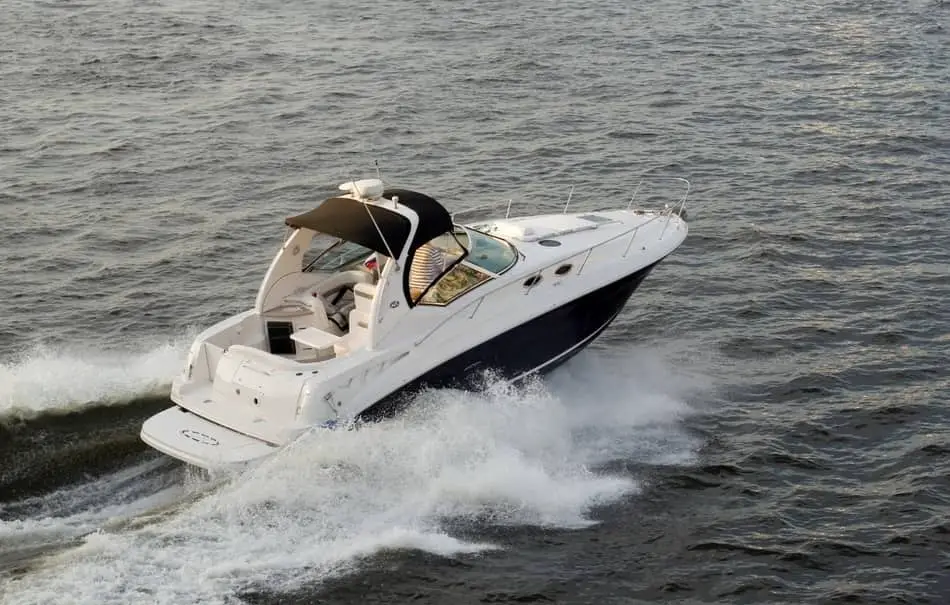
On average, a cabin cruiser boat gets around 1 mpg (miles per gallon) at MAX RPMs. However, the mileage can vary from as small as 0.5 mpg or less to as high as 2 mpg or more depending on the weather condition, boat’s weight, boat’s condition, RPMs, and most importantly, the boat’s engine type, etc.
Cabin cruiser boats are just like mobile mini homes that you can use to take the entire family on adventures. Even with small cabin cruisers, you have the flexibility to visit new ports, spend long weekends enjoying the boating lifestyle, or just kick back for a day of swimming and relaxing on the water.
Being bigger in size than most boats (and weighing more) gives less mileage. This makes cabin cruisers one of the least fuel-efficient boats used by most recreational boaters. However, proper maintenance and careful cruising can help improve the boat’s gas efficiency.
So cabin cruiser boats give less mpg compared to pontoon boats, bass boats, cuddy cabins, fishing boats, etc. Here’s a table showing the different cabin cruiser boat models and their average mileages.
| Cabin Cruiser Model | Engine | Miles Per Gallon (At Full Throttle) |
| Jeanneau Leader 10.5 Series 2 | Yamaha XF425 | 1.3 mpg |
| Jeanneau Leader 12.5 | Yamaha F300XCA | 0.65 mpg |
| Back Cove 34O | Twin Yamaha 300 hp | 1 mpg |
| Chris-Craft 34 Corsair | Twin Mercury V8 6.2L | 1.2 mpg |
| Sea Ray Sundancer 320 | Twin MerCruiser 6.2L | 1.5 mpg |
| The Grand Banks Eastbay 44 | Twin Volvo Penta IPS 650S | 0.75 mpg |
| Intrepid 409 Valor | Triple Mercury 450/400R | 1.9 mpg |
| Tiara 43 LE | Triple Yamaha 425 XTO | 1.1 mpg |
| Azimut Magellano 43 | Twin Cummins QSB 6.7 | 1.6 mpg |
| Regal 33 Express Cruiser | Twin Volvo V6 280 DP CAT EVC | 0.6 mpg |
A cabin cruiser becomes a small yacht if the size increases furthermore, accumulating more space on board. A cabin cruiser also has an area behind the cockpit that is open to the outdoors. This makes a great area for resting in the sun or for fishing, crabbing, and more.
A cabin cruiser will generally range anywhere from $100,000.00 to $500,000.00. Below $100,000, and you’re probably looking at a cuddy cabin and above $500,000.00, and you’re probably looking at a yacht or trawler.
Go Downsize
How Many Miles Per Gallon Does A Cuddy Cabin Boat Get?
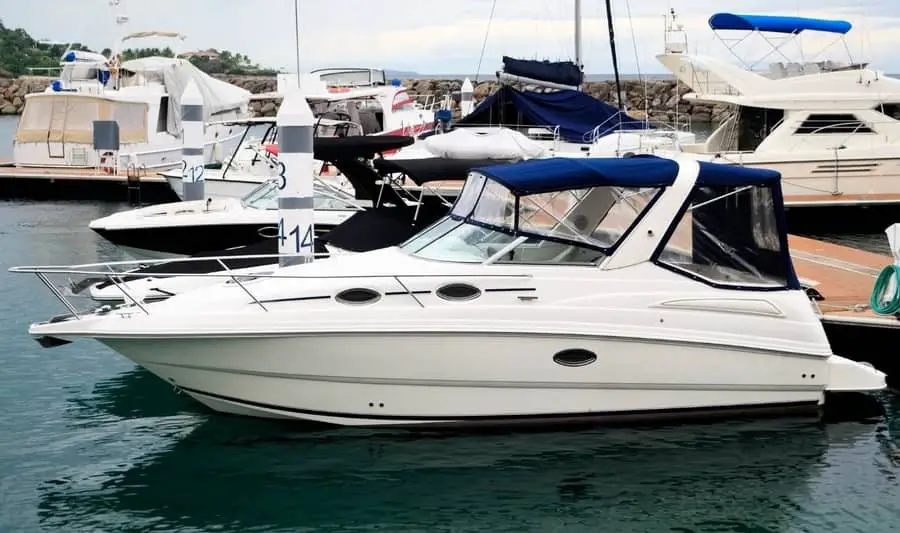
On average, a cuddy cabin boat gets around 2.5 mpg (miles per gallon) at MAX RPMs. However, the mileage can vary from as small as 1 mpg or less to as high as 4 mpg or more depending on the weather condition, boat’s weight, boat’s condition, RPMs, and most importantly, the boat’s engine type, etc.
Cuddy cabin boats offer day cruisers an interior space to sleep at night. These boats are often built like bowrider boats in the center and rear of the boat, but the front holds a cabin rather than a sitting area.
In fact, the average size of a cuddy cabin is between 18 and 28 feet long. Anything larger, and you’re probably dealing with a cabin cruiser rather than a cuddy cabin. Here’s a table showing the different cuddy cabin boat models and their average mileages.
| Cuddy Cabin Model | Engine | Miles Per Gallon (At Full Throttle) |
| Pursuit 2860 Denali | Twin 4.3l EFI Merc’s | 1 mpg |
| Crownline 264 cr | Yamaha 350 hp | 2.8 mpg |
| Bayliner VR5 | MerCruiser 4.5L | 2.6 mpg |
| Rinker 29QX | Mercruiser 3.0L 135 hp | 2.2 mpg |
| Rinker 22MTX | Yamaha 35 hp | 2.4 mpg |
| 20 Proline Hardtop | Mercury 150 hp | 1.9 mph |
| Pursuit 2460 Denali | Mercruiser 5.7LX-efi 250hp Bravo III | 1.2 mpg |
| 22 Sea Hunt 225 Victory | Yamaha 250 hp | 2.64 mpg |
| Stingray 225cr | I/O 240 hp | 3.4 mpg |
| Stingray 250cr | Volvo Penta V6-DPS | 2.8 mph |
Cuddy cabin boats need a lot of fuel depending on the size and the usage. If you are cruising all day and want to sleep overnight, at least a 100-gallon tank is a must. Anything lower than that means you are at risk and should use the fuel accordingly.
Related post – Is Boat Fuel Expensive? Check this article to know more about the cost of the fuel that is used in boats and how they distinguish from normal gas station prices.
How Many Miles Per Gallon Does A Fishing Boat Get?
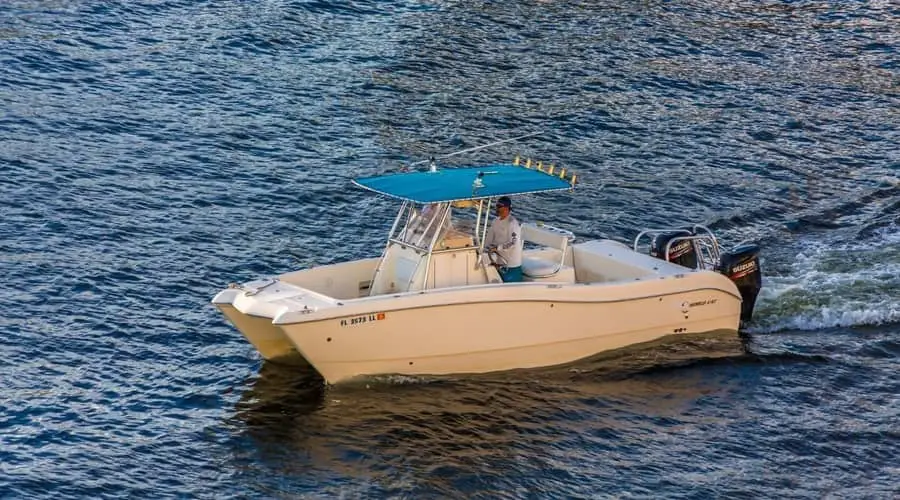
On average, a fishing boat gets around 2 mpg (miles per gallon) at MAX RPMs. However, the mileage can vary from as small as 1 mpg or less to as high as 4 mpg or more depending on the weather condition, boat’s weight, boat’s condition, RPMs, and most importantly, the boat’s engine type, etc.
Now we are talking about the offshore fishing vessels (like center consoles, etc.), not the small fishing boats like (Bass boats, Jon boats, etc.). Offshore imply harsh weather (choppy waters), which drastically increases fuel consumption and decreases mileage drastically.
Generally, offshore fishing boats have at least one live baitwell, tackle centers, bait prep centers, fish boxes for safely storing the day’s catch, and rod holders for storage and strategically placed for trolling—higher gunwales to keep passengers safely on board.
Most will have extensive electronics for fish finding, navigation, marking hot spots, and monitoring systems, including propulsion systems.
MarineMax
Offshore fishing boats are designed to safely endure the severity of the open ocean while providing a platform for searching out larger fish. Here’s a table showing the different fishing boat models and their average mileages.
| Fishing Boat Model | Engine | Miles Per Gallon (At Full Throttle) |
| Tidewater 2110 Bay | Yamaha F150 hp | 3.5 mpg |
| Triton 240 LTS | Yamaha F250 B | 2.2 mpg |
| Pathfinder 2400 Trs | Honda 225 hp | 2 mpg |
| Pro-Line 23 Sport | Suzuki DF-250 | 1.8 mpg |
| Judge 27 Chesapeake | Honda 250 | 1.5 mpg |
| Boston Whaler 190 Outrage | Mercury 150 | 3.5 mpg |
| Seavee 290 | Twin Suzuki DF300AP | 1.6 mpg |
| Regulator 23 | Twin 150 HP | 1.1 mpg |
| Sea Hunt Gamefish 25 | Yamaha 250 hp | 1.4 mpg |
| Boston Whaler 230 Outrage | Yamaha 250 hp | 1 mpg |
Related Post – Do Boat Use The Same Gas As Car? Check this article to know the difference between the boat and car gasoline in a detailed way.
Key Takeaways
A standard boat gets around 3 mpg (miles per gallon) at MAX RPMs on average. However, the mileage can vary from as small as 0.5 mpg or less to as high as 8 mpg or more depending on the weather condition, boat’s weight, boat’s condition, RPMs, and most importantly, the boat’s engine type, etc.
Boats are not as fuel-efficient as cars. They consume a lot of gas compared to other vehicles due to their traversing in the waters. That’s the main reason why boats have bigger fuel tanks compared to other land-moving vehicles. Low mileage means requires more fuel.
Many small boats tend to get around 3 – 12 mpg at normal speeds (not at max RPMs), while faster boats like speed and motorboats will give 0.5 – 2.5 mpg. Depending on the boat’s weight, design, and, very importantly, the type of motor it has, the mpg or mileage changes drastically.
